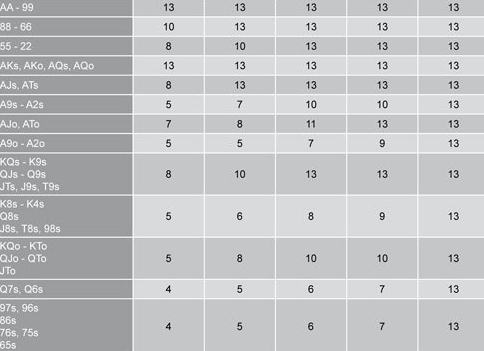
I want to convey to you, dear friends, that stack size plays a very important role at different stages of an MTT tournament.
A player’s participation in tournament hands ends when they lose their last chips. If a participant has a critically small number of chips left, they find themselves in a vulnerable position, and their options for action are significantly reduced. In such situations, the player will no longer be able to comfortably raise bets, steal blinds, or call opponents’ bets.

A strategy called push-fold has been developed for such playing circumstances. The use of this strategy becomes justified when a player does not have enough chips to participate in full-fledged bidding, that is, when his bets or raises cannot be threatening to opponents with longer stacks. The push-fold strategy is based on two actions: going all-in and folding.
When to use the push-fold strategy in MTT tournaments
Each tournament player chooses a strategy for each stage of the game depending on the ratio of their stack size to the blinds. A long stack allows you to diversify your actions and play a wider range of hands. However, most tournament participants sooner or later face the problem of their stack shrinking to a critical point, which is 12-13 big blinds.
In this situation, the player should not perceive the situation as a failure, because with smart play and well-thought-out actions, they can increase the number of chips and at least get into the prize zone.
With a stack not exceeding 12 BB, the player is advised to use a push-fold strategy, which is perfect for MTT tournaments. By following the basic principles of this approach, the player will not lose the rest of their stack on blinds and will be able to get past the dangerous mark in most cases.
In the situation described, the player can only take two actions, trying to limit themselves to the preflop stage:
- Go all-in. To make such a decision, the player needs a combination of certain conditions and circumstances: promising pocket cards, positional advantage, opponents with a tight-passive playing style.
- Fold. The reason for this choice is the absence of the above-mentioned advantageous factors.
For novice players and those who have not yet reached the professional level, a system of charts and rebound tables has been developed to help determine the most appropriate action for the current stack size, position at the table, and pocket cards. Pros do not use such materials, as their experience allows them to conduct a more in-depth analysis of the current game situation, but for beginners, such tables will be extremely useful.
Key factors influencing the use of the push-fold strategy in poker
For a complete analysis of the situation, a player needs to understand the influence of key factors on decision-making. These include the playing style of opponents, the size of the stacks of the participants in the hand, and the situation at the table and in the tournament as a whole.
The typical actions of opponents allow the player to understand when it is appropriate to bet everything and when it is better to refrain from such a decision. Many tournament players are characterized by certain actions: calling in response to a preflop raise, floating, raising the bet if previous opponents have folded. Knowing the typical actions of opponents, a player can form an opinion about which of them should be used to make a restyle, and with whom it is better not to enter into a draw with medium-strength hands, since such an opponent’s tendency to call a raise has been noticed.
The size of opponents’ stacks affects their actions in response to a player’s all-in, so you should carefully analyze the likely responses to such a move. You should also take into account the player’s style and their ability to adequately perceive ranges. With experience, you will immediately understand what kind of player you are facing and how to play against them.
| Your hand | Early position | Middle position | cut-off | button | small blind |

Opponents with medium bankrolls are most suitable for increasing the stack through blinds and antes, as they are in a zone of relative comfort and will not take risks by responding to an all-in. Such opponents will most often adhere to a tight style of play, and it will not be difficult for them to fold their cards when they receive an all-in from an opponent. Players with short stacks will call all-in even with the slightest hope that their opponent has resorted to a light push, as they themselves are in a rather dire situation. Opponents with large stacks are the most unpredictable, as it will not be difficult for them to call a push from a short-stacked player. In addition, by winning such a hand, the opponent will increase their capital and be able to dictate the terms in the further play.
The stage of the tournament also has an impact on the use of the push-fold strategy. The bubble is considered the most suitable stage for this, as many participants will stick to a tight-passive playing style in order to reach the prize zone with the least losses. However, there may be situations on the bubble that cause concern: a raise from an opponent who has been playing strictly according to the push-fold strategy or from a player with a reputation for being tight. In such cases, you need to immediately fold your cards so as not to be left out of the game one step away from the prizes.
The short conclusion is this:
In MTT tournaments, using push-fold always helps you get out of a difficult situation when you have a short stack. It is useful for novice players to use starting hand charts to play according to this principle.
